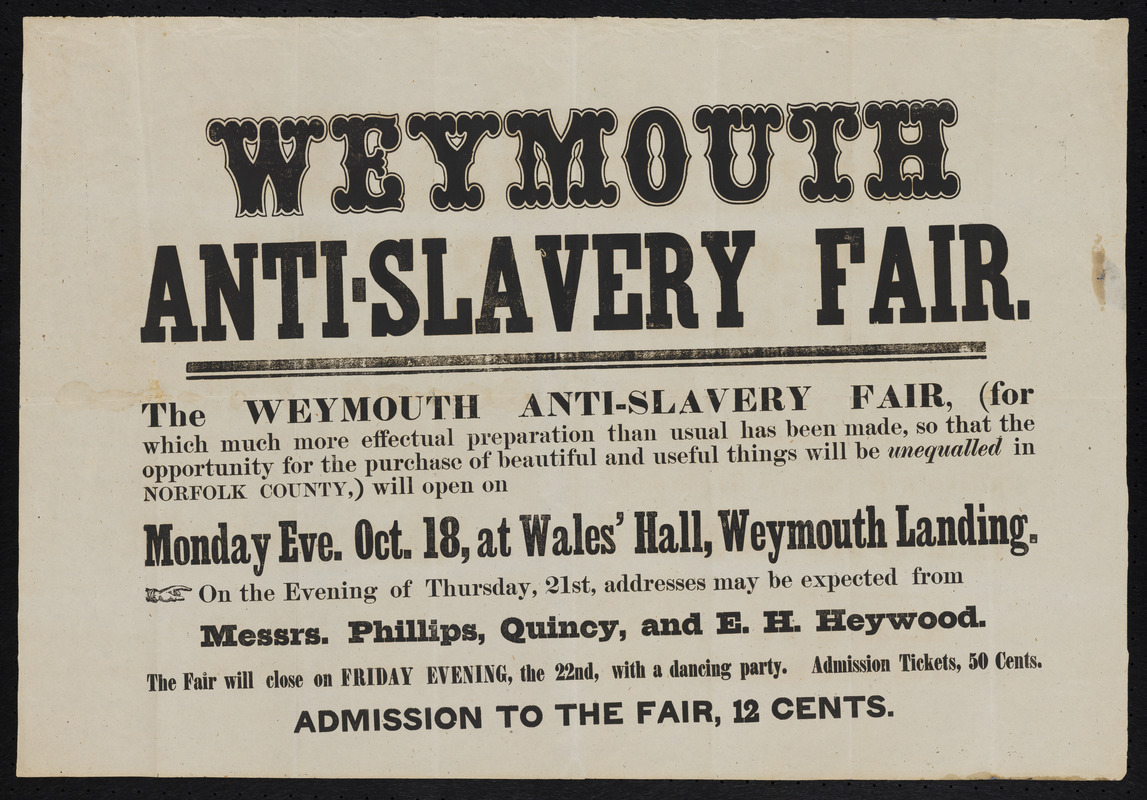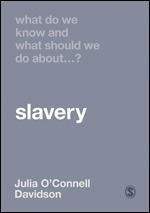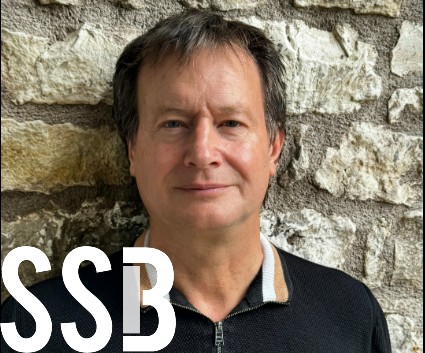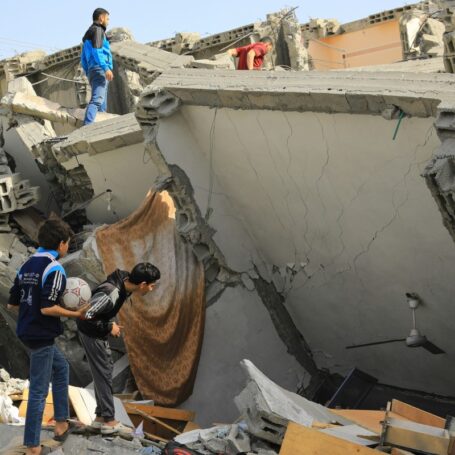Julia O’Connell Davidson on the Hope and the Hypocrisy of Addressing ‘Modern Slavery’
Sociologist Julia O’Connell Davidson has long been examining the various components of exploitation and violence that often get lumped into the catch-all term of outrage, ‘modern slavery.’ As she explains below, even while she writes about the underlying issues at length, notably in her new book, What Do We Know and What Should We Do About Slavery? the idea of ‘modern slavery’ is a “capacious ragbag of a concept” that shadows as much as it illuminates.
“Precisely because it’s such a vague and elastic concept … it can be selectively invoked to justify policies that actively and grossly harm various groups of people,” she argues, especially when it’s wielded by people with power even as they affect a pose of serving the common good.

O’Connell Davidson is a professor in social research in the School of Sociology, Politics and International Studies at the University of Bristol. She earned a PhD in sociology from Bristol in the late 1980s and has researched issues at the nexus of work, sex, movement and policy swirling around any discussions of exploitation today and the “afterlives” of slavery’s historical victims ever since.
She currently holds a European Research Council Advanced Grant for the project “Modern Marronage? The Pursuit and Practice of Freedom in the Contemporary World.” Britain’s Economic and Social Research Council (ESRC) and the British Academy O’Connell Davidson have funded projects she’s led investigating the informal tourism economy in the Caribbean, another ESRC award funded her study of the markets for migrant domestic and sex workers in the UK and Spain, and a Leverhulme Major Research Fellowship saw he research “Modern Slavery and the Margins of Freedom: Debtors, Detainees and Children.”
Social Science Space: Professor O’Connell Davidson, I see that you have a background in sociology. Could you outline how you came to be interested in researching modern-day slavery?
Julia O’Connell Davidson: In the early 2000s, there was huge media, political and policy interest in what was termed ‘human trafficking.’ This interest was partly stoked by a new brand of antislavery non-governmental organizations (NGOs) that had sprung up. Their campaigns spoke about people being trafficked by criminals into ‘modern slavery’ in various sectors and settings, and claimed that trafficking was the modern-day equivalent of the transatlantic slave trade. This claim reflected a rather startling disregard for historical and sociological realities – the victims of the transatlantic slave trade did not want to travel to the Americas, it took overwhelming physical force to transport them, whereas people described as ‘victims of trafficking’ today almost invariably want to move, and have excellent reasons for wishing to do so.
However, the idea of trafficking as a modern-day slave trade was quickly mainstreamed, not least because it was extremely convenient for governmental actors and politicians who wanted to control and restrict immigration.
Global North states were busily introducing extremely harsh measures to combat unauthorized migration, measures that were actually compromising very basic human rights, such as the right to move in search of asylum. We were seeing ever larger numbers of people dying as a result of border controls that forced them to take increasingly risky journeys by sea and across deserts. Anti-migration politicians used the terms ‘trafficking’ and ‘smuggling’ interchangeably, and the beauty of describing them as processes by which people were moved across borders and into ‘modern slavery’ by evil criminals was that it made vicious, often lethal, immigration policies appear necessary and justifiable.
When anybody pointed out that increasingly restrictive immigration regimes and militarized borders were leading to massive violations of the human rights of people on the move, state actors could say, “Oh, but we have to do this to tackle the scourge of trafficking and modern slavery.” It was a great way to give a humanitarian gloss to state violence.
So, I became very interested in the hypocrisy that this concept of “modern slavery” was opening the door to. I wanted to dig into that, to see how it played out in various different contexts, whether it had historical resonances with antislavery of the 18th and 19th centuries, what the people who were described as actual or potential “modern slaves” actually thought about that label and the measures being taken to combat “trafficking,” and so on.
Lots of things get grouped under the idea of modern slavery, depending on who is talking and the point they’re trying to make. When you talk and write about modern slavery, what forms of exploitation do you include?
Julia O’Connell Davidson: Yes, ‘modern slavery’ — as antislavery NGOs use it — is a massively capacious ragbag of a concept that can accommodate entirely disparate phenomena in completely different contexts – everything from brick kiln workers in India who are tied to employers by debt, through runaway teenagers in Jamaica who are selling sex to survive, to teenagers involved in ‘County Lines’ drug dealing in the UK. Antislavery activists say that whilst superficially different, all manifestations of ‘modern slavery’ have three common features – the individual affected did not choose their condition, is prevented from leaving it by violence or its threat, and is paid nothing, or only enough for mere subsistence.
But antislavery campaigners and their government allies are highly selective in their application of these criteria. Teenagers who are involved in sex work or drug dealing get described as ‘modern slaves’ even when they experience none of these supposedly common features. Meanwhile, other people who do experience all three elements are not included in ‘modern slavery’ talk. For example, the many thousands of people forcibly detained in immigration centers and prevented from leaving under threat of violence are not discussed as victims of ‘modern slavery,’ and this despite the profits made from their incarceration by private companies that run detention centers, and the fact that immigration detainees often work inside detention centers where they are paid far less than the minimum wage.
So I don’t use the term ‘modern slavery’ when I’m talking and writing about the many forms of exploitation and violence that exist in the contemporary world. It’s too poorly defined to be analytically useful. And it’s precisely because it’s such a vague and elastic concept that it can be selectively invoked to justify policies that actively and grossly harm various groups of people – migrants and asylum seekers being the most obvious example, but also sex workers, and in some contexts child laborers.
Does the nomenclature matter?
Julia O’Connell Davidson: I would say it matters a lot. Sure, if you call something ‘modern slavery,’ many people will be indignant about it because it’s almost unanimously agreed that slavery is wrong. But slavery no longer exists as a legally recognized system or status, so what exactly is that you are calling on them to struggle against, and what do you want them to struggle for?
Think, for example, of an irregular migrant or asylum seeker who is found living and working in appalling conditions in a car wash or a brothel in the UK for below the minimum wage or simply in exchange for a roof over their head and something to eat, and whose employer threatens them with violence if they try to leave. This doesn’t happen because the victims have slave status in law. It happens because their immigration status prevents them from working legally and denies them a whole raft of rights that somebody like me enjoys in the UK. So, to survive, they are forced into dependence on other people, and it’s the luck of the draw whether the person who offers them work or accommodation goes on to help or harm them. If they are unlucky, and they fall into the hands of someone exploitative and/or violent, again it’s not slave status that prevents them from escaping, but their immigration status. They can’t turn to the authorities for help, because they know the authorities are ready to perpetrate even greater violence – not only forcibly deprive them of their liberty and hold them in detention, but now potentially shackle them and force them onto a plane to Rwanda.
If you call the exploited car wash or brothel worker a victim of ‘modern slavery,’ you deflect attention from the structures that actually created their vulnerability to exploitation. This means you can end up with politicians like Theresa May, Priti Patel or Suella Braverman loudly advertising how much they weep for and deeply sympathize with victims of ‘modern slavery’ whilst at the same presiding over immigration systems and policies that not only strip migrants and asylum seekers of protections against exploitation and abuse by private actors, but also directly expose them to brutal violence by state actors.
Naming the problem ‘slavery’ makes it appear that the solution is just tougher laws and punishments for wicked private actors. But as John Locke famously observed, we don’t only need laws to protect us against our neighbors. We also to be protected against the state. To ignore the latter, he said, is to imagine “that men are so foolish, that they take care to avoid what mischiefs may be done them by pole-cats, or foxes; but are content, nay, think it safety, to be devoured by lions” (with, in this instance, the pole-cats and foxes being the “traffickers” and unscrupulous employers, the lions being Suella Braverman and her ilk).
The same basic argument applies to forms of exploitation and abuse experienced by other, non-migrant groups that also get discussed as ‘modern slavery.’ Consider a homeless young British man with alcohol or drug issues who is found being exploited as a day laborer in exchange for shoddy substandard accommodation and a paltry subsistence, and threatened with violence. He’s not vulnerable to abuse because he has slave status. What has left him open to predation by unscrupulous others is the absence of social housing and other forms of social protection, including support services for people with mental health and addiction problems, that has come about in a rich country like Britain as a result of years of austerity and assaults on the welfare system.
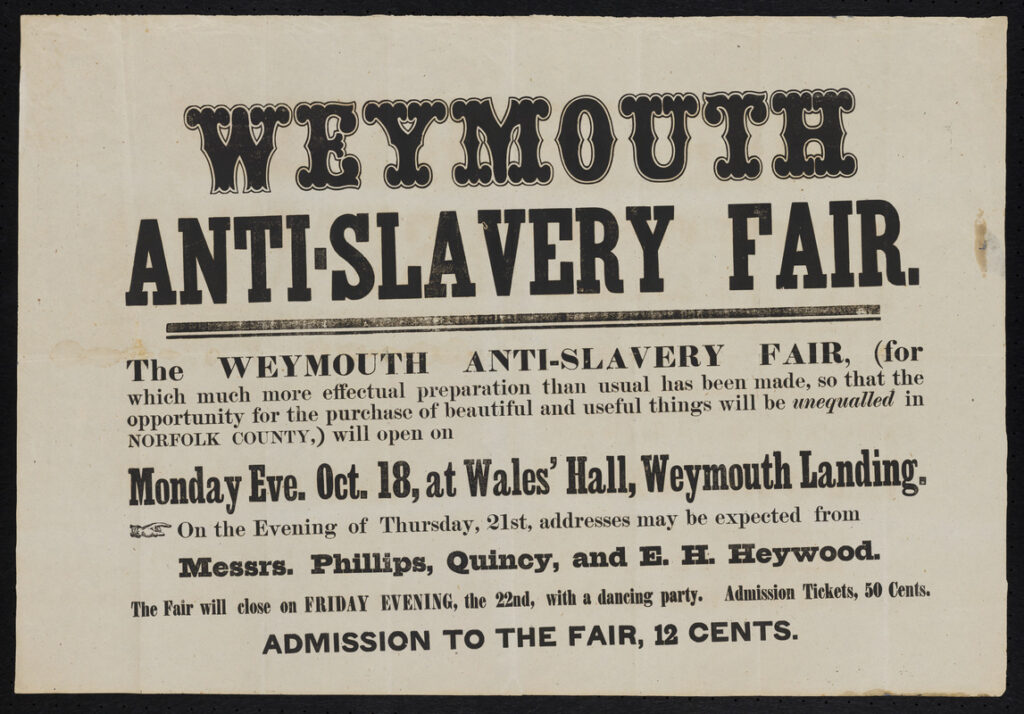
You’ve noted before that a lot of people view slavery as something historical, as indeed the Atlantic slave trade, chattel slavery or the Zanzibar market are. Does the history of slavery make it hard to talk to people about the present (and likely future) of slavery?
Julia O’Connell Davidson: In Europe, North America and Australia people are taught a very particular version of the history of slavery. We learn that slavery is something barbaric and horrible that existed in pre-modern, illiberal societies. Atlantic World slavery was supposedly the last vestige of that old world, and as liberal values of equality and liberty took hold in Europe and the Americas, so slavery was recognized for the evil that it is and abolished.
In British schools, for instance, next to nothing is taught about Britain’s heavy and sustained involvement in the slave trade and slavery. The emphasis is all on celebrating the (mostly white) heroes of the antislavery movement. This makes it very easy for the new antislavery NGOs to proselytize against what they claim is present-day slavery. When they talk about evil criminals trafficking “slavery” into modern, liberty-loving global north societies, it evokes intense, but quite emotionally satisfying, outrage. And when they talk about “slavery” persisting in global south societies that are imagined as “traditional,” it evokes pity and a desire to save poor benighted women and children from their “backward” cultures.
What is harder to talk about is first, the fact that Atlantic World slavery developed and prospered alongside capitalist modernity. It was “modern slavery,” and liberal thinkers did not necessarily have to wrestle hard to accommodate it. Liberalism always had certain exclusion clauses concerning who was entitled to rights and freedoms. Women, children, colonized peoples, and enslaved people were not included in the category of “all men” who stood equal before the law. Even white working men were historically denied many of the rights and liberties enjoyed by propertied white men in Britain and America, and had to struggle politically to secure them.
Second, what distinguished modern, Atlantic World slavery from previous systems of slavery was its scale, organization and racialized character. It was not only modern slavery, it was racial slavery. It racialized both slavery and freedom, as black and white respectively. By racializing freedom as white, it slavery provided the foundations for the architecture of white supremacist societies, and white supremacy was not abolished along with slavery.
It’s more difficult to talk about these aspects of slavery and its afterlives because many people are discomforted by complicated narratives. A simple story about a modern liberal hero vanquishing the old order and creating free, equal, and meritocratic society is less troubling than having to grapple with the fact that liberalism can simultaneously embody an inspiring call for human liberty, and license highly illiberal acts and relationships.
So people who grow up in liberal capitalist societies, including some people who are racialized as Black or brown as well as many who are racialized as white, are often deeply invested in myths about the unfailing righteousness of their societies, and feel very threatened by talk of the atrocities and injustices that those societies have historically enacted or been complicit with, as well as talk of the injustices and inequalities they continue to tolerate.
Thinking about the aphorism that the past is never dead, it’s not even past, what is the nexus between ‘slavery of the past’ and harmed populations of the present?
Julia O’Connell Davidson: The legal abolition of slavery did not magically erase the racial inequalities and structures of white supremacy that had been built into modern, racial, liberal capitalist societies through the centuries of Atlantic World slavery. Former slaveholders were often compensated for the loss of their human ‘property,’ but no reparations were made to those who had endured enslavement. In fact, what happened to the formerly enslaved and their descendants after “emancipation” was often almost as violent, unjust and exploitative as what happened under slavery. And it isn’t over yet. Slavery’s past continues to reach into a present where Black lives are diminished, right from the start.
In the US, Brazil and the UK, infant deaths per 1000 live births amongst the Black population are also almost twice the national average. In the US, only 28 percent of people racialized as Black graduated from college in 2016, compared to 42 percent of those racialized as white. The poverty rate amongst Black Americans is almost triple that amongst those racialized as white, homeownership rates are significantly lower, and the median household income for Black Americans is around $20,000 less than that for white Americans.
There are also huge and persistent racial disparities in terms of health. The same patterns are repeated in the UK, where health inequalities are also racialized, white Britons are almost twice as likely to own their own homes than are people racialized as Black, and the unemployment rate of Black Britons was almost twice that of white Britons between 2004 and 2018.
The brutal murder of George Floyd in 2020 drew the world’s attention to the gross racial inequality and violence that characterizes policing in the US, and again, that’s not unique to the States. In the UK, Black people are 10 times more likely than white to be stopped and searched by the police, police figures show that Black people were up to eight times more likely to be tasered by police than white people in 2018-19. In Brazil over the past decade, police have killed 33,000 people, 9,000 in Rio de Janeiro alone, and of the latter, more than 75 percent of those murdered were Black men. In 2019, 75 percent of people killed by the military police in all Brazil were Afro-Brazilian (preto and pardo), a group that represents 56 percent of the population.
There are also links between histories of slavery and colonization and the systems of border control that today operate to maintain a form of neo-colonial, global apartheid. It is the movement of people from global south countries that have been impoverished by histories of slavery, colonialism and empire that is most heavily and systematically constrained by the current system of national-state control over human mobility, hence it is migrants from the global south that are made most vulnerable to the forms of labor exploitation and abuse that antislavery actors dub “modern slavery.”
Tell me about What Do We Know and What Should We Do About Slavery the book. What was the book’s genesis?
Julia O’Connell Davidson: There are two very different conversations about slavery taking place at the moment, one largely driven by antislavery campaigners and NGOs, the other by activists and scholars who think critically about race and colonialism, and who argue that the racial inequality, violence and oppression set in place by Atlantic World slavery remains an on-going social problem. And I was struck by the very stark contrast between the way that mainstream media and political figures respond to these two conversations. Talking about ‘the scourge of modern slavery’ is so politically anodyne that even the BBC’s long-running radio soap opera The Archers could have a story line about it. Mainstream media coverage simply accepts and reproduces antislavery NGOs’ claims about “modern slavery,” politicians of all political hues decry it. But journalists typically present critical analysis of the afterlives of Atlantic World slavery as “controversial,” and politicians are much more circumspect about making statements or symbolic gestures in support of Black Lives Matter (BLM) activism. In fact, in the UK in October 2020, Kemi Badenoch, women and equalities minister, went so far as to say that it is unlawful for schools to teach certain elements of critical race theory as fact. So, the book was inspired by a desire to address both of these different perspectives on slavery as a contemporary issue in one place, and to try to think through whether and how they are related to one another.
What are one or two things you’d hope a reader will walk away with after reading the book?
Julia O’Connell Davidson: I would hope that readers who have only ever been exposed to the mainstream discourse on “modern slavery” would walk away with a more critical take on it. I hope they would see that although NGOs campaigning against trafficking and modern slavery are obviously motivated by a concern with human flourishing and freedom, the term “modern slavery” and their focus on criminality is very easily co-opted by state actors and powerful elites that have no interest whatsoever in changing the existing status quo. I’d also hope the book had sparked their interest in the “afterlives of slavery” perspective that challenges existing structural and systemic inequalities and injustice, and also in the demands that emerge out “afterlives” thinking (calls for reparations, border abolition, fundamental changes to criminal justice systems, and what W. E. B. DuBois termed “abolition democracy”).
For readers who are actively part of the current antislavery movement, I hope I’ve communicated that I appreciate their efforts to hold states to their existing obligations under international law, because in so far as they do this, I believe the world they pursue is a better one than that we currently live in. But I also hope the book would encourage them to reflect on how to ensure that their messaging cannot be co-opted by state actors to justify further criminalization of already marginalized communities, and to engage much more closely and seriously with “afterlives” thinking. Because the book’s conclusion is that, if fulfilled, the demands for change articulated by “afterlives” scholars and activists could not only help to ensure that black lives matter, but also go a long way towards addressing the situation of those described as victims of, or vulnerable to, “modern slavery.”
Desmond Tutu is often quoted as saying that there comes a point when we need to stop just pulling people out of the river, we need to go upstream and find out why they’re falling in. And the book’s message is that if you go upstream, you find that the select few that antislavery and state actors are pulling out of the river did not fall in because some exceptionally bad criminals are operating a system of ‘modern slavery’ that is antithetical to the values of global liberal capitalism. They fell in because of policies that many liberal states pursue and defend (restrictive and racist immigration controls, ‘hostile environments’, cuts to welfare, criminalization of sex workers and of homelessness, etc.); and/or because the global north continues to aggressively extract wealth from the global south in the form of raw materials and human labor power leading to a race to the bottom in terms of labor standards and protections; and/or because of other forms of injustice and inequality that are widely tolerated or regarded as sadly inevitable.
For me, the great lesson taught by the original antislavery movement is that it is possible to transform popular beliefs about the inevitability of injustice and oppression. Slavery was once regarded as an inescapable feature of human societies, even by those who saw it as regrettable. Today, it’s universally outlawed and condemned. Nobody actively argues in favor of it. That is cause for cautious optimism about some of the systems and inequalities that today cause people to “fall into the river,” yet are currently considered inevitable or necessary.
